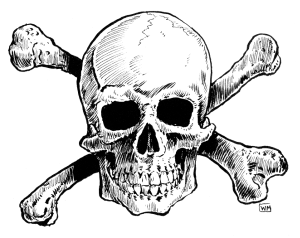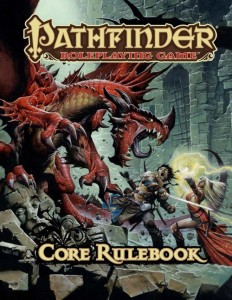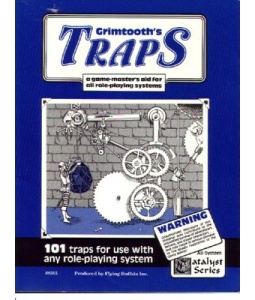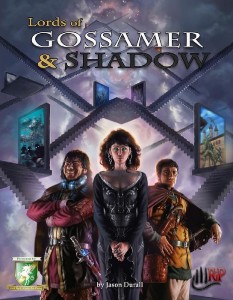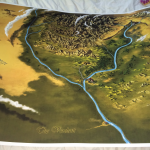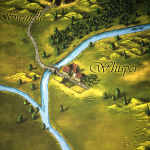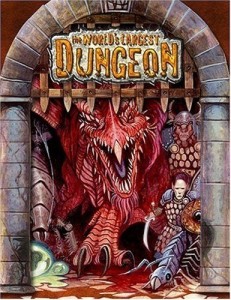Late in October I asked for some megadungeon advice. I’ve dabbled in Barrowmaze and had Stonehell on order when I made that post. I have not read all the way through Stonehell just yet, but from what I have read so far I think it would work quite well for a megadungeon campaign. There is enough going on to keep things interesting and for the GM to play off of.
Now I am down to trying to decide which ruleset to use. I am a big fan of Swords & Wizardry. But if I get this off the ground – this campaign is supposed to be a short term winter time campaign and I am looking for the path of least resistance – which means maybe I should run it in Labyrinth Lord to avoid any conversion whatsoever. I want the time I spend on the campaign to be building threads of intrigue – not conversion, regardless of how easy it is to convert between OSR systems.
Comments are welcomed on the S&W versus LL decision that needs made.
As I write this the first snow of the season is about to be upon Ohio. If I am going to get this winter campaign going I need to get moving! The first thing I needed was a large town to be the base of operations. Feeling a little guilty for running a published adventure instead of writing my own, I attempt to remedy that by creating my own town for the characters to work out of.
I had a rough idea of what I wanted and drew up a map. With map in hand I did a short write-up on the town. I like to have just enough framework that I understand the town, establishment, NPC, etc that I can run with it on the fly. So the write-up briefly touches on the town’s history, what makes it thrive today, and establish a general feel of the place. By putting these thoughts down I am much better prepared to handle things on the fly during a game session.
I present you the Town of Thassel!
Thassel
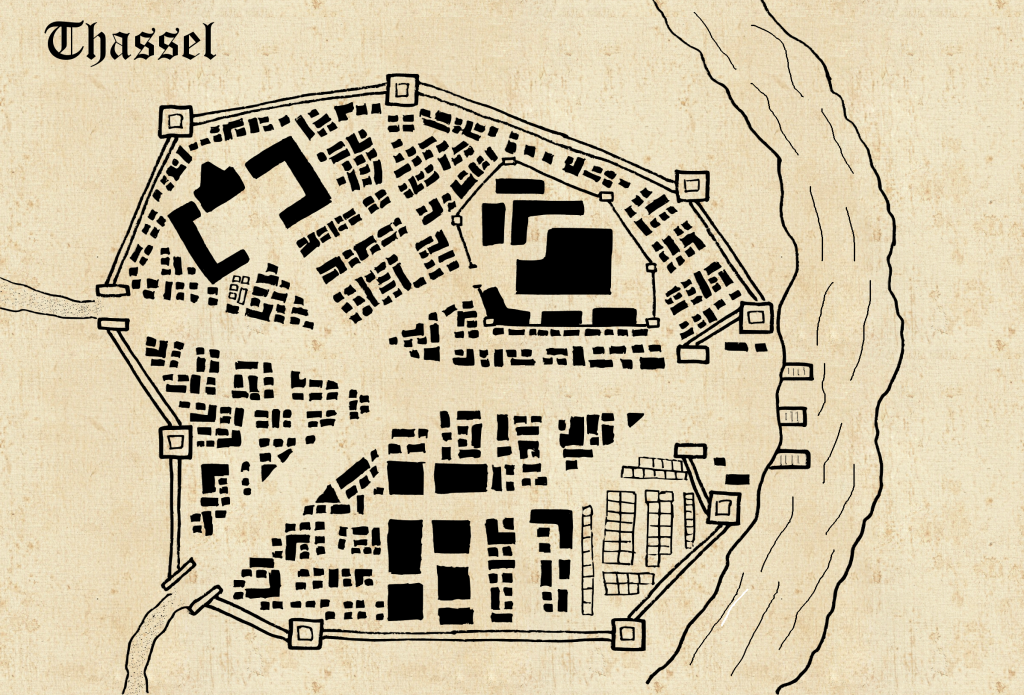
Thassel, a large town, sits south of the Ironcrag mountain range along the Silver River. Thassel’s population numbers around 5,000 residents, though the number fluctuates based on the mining season.
Thassel has existed along the river for centuries. With the downfall of a great kingdom centuries past it struggled as a small mountain town for decade after decade. Ten years ago rich mineral deposits were found in the Ironcrag mountains bringing an influx of people to the town.
Damaged buildings and city walls were repaired as the town was shortly returned to a time of prosperity. The flow of mining revenues and associated services soon had the town bustling with activity as merchants sold their wares and mining companies established bases of operations for their activities in the mountains to the north.
The Mining Companies
Within two years two predominant mining companies had solid footholds for their business in Thassel. Ravenflight Mining maintains the majority of their holdings in an area of mountains northwest of the city. Rusted Hammer Mining maintains their stakes in a northeastern portion of the range.
Ravenflight Mining was one of the early companies to establish claims when richer deposits of silver and iron were discovered. They organized quickly and staked out several mining areas in the easier to reach slopes and canyons of the mountains. Using these as their basis they expanded into harder to reach portions of the mountain range. They protected their claims vigorously, and are not beyond using physical intimidation to keep other miners – both organized and independent away.
Rusted Hammer Mining formed out of a trio of independent mining groups struggling to work their claims as Ravenflight Mining grew in size. With mines northeast of town in the Ironcrags transport of the mined ores was problematic. These three banded together with the idea of combining resources and floating their excavated product doe the Silver River. Met with skepticism the newly formed Rusted Hammer Mining company did just that. Soon the river was busy with their boats working their way up and downstream. So successful were they in this means of moving the ores out of the mountains by water they quickly rose to be the other prominent mining company in town.
While Ravenflight Mining and Rusted Hammer Mining are competitors, the Ironcrag Mountains offer enough ore rich deposits to keep the rivalry between the two from escalating too violently. Both honor each others claims for the most part and save for an occasional brawl breaking out in a tavern between intoxicated workers the relations are peaceable enough.
Government
Thassel is governed by a council of five members. Ravenflight Mining and Rusted Hammer Mining each have a representative on the council. A third spot is held by a merchant guild who oversees many of the market booths. The fourth position on the council is held by one wealth, selected during an annual banquet in the government district of Thassel. The fifth and final position is held by a person selected by the popular community, also during an open meeting once a year. Many suspect the fifth position is simply a facade and pre-selected by the other four council members prior to any open meeting.
Despite a bias towards the mining industry and commerce in general, the council has served the town of Thassel well. The mining companies have kept a steady influx of residents employed and the monies earned typically flow back through town. Thassel is in better shape than just a decade ago and continues to thrive as long as the ores in the Ironcrags continues to be mined in a profitable quantity.
The council maintains a city watch, supplemented by volunteers. At least some loose sense of rule and law is maintained in the town. While tavern fights spilling into the street may go unpunished, murders and anything above petty theft is bound to be met with some form of punishment meted out. Activities that interfere with either mining operation are apt to be dealt with more heavy handedly.
Thassel and Stonehell
Thassel was once a city-state within a kingdom of authoritarian rule over a century ago. The kingdom fell, its people liberated from their ruthless and often sadistic potentate. Thassel struggled in the time that went by, finally beginning rebuilding as ores were found in the Ironcrags north of the town.
As Thassel began to flourish again, the tales of Stonehell, now a crumbling prison, began to spread amongst the townspeople. Stories of the horrors that occurred there over a century ago and the rumored atrocities that still occur at the hands of a myriad of occupants.
The stories of Stonehell spread and with them came an influx of adventurers and risk takers. Many seeking riches, some seeking fame. Some adventurers never return from the prison, some return changed, and others come back through buying drinks for any at their tavern of choice.
Stonehell resides a six hour journey from the town of Thassel, a spur of a worn path turning from the main mining camp route to the west and heading north into the narrow canyons of the Ironcrags.
Bandits are said to live in the forest at the base of the mountains, the same ones that prey on payroll caravans to the mining camps in the mountains. When the problem becomes too bad the Thassel council and mining companies out up an amount of gold and sellswords head that way to deal with the problem. Sometimes they chase the bandits from their hideouts, sometimes the bandits turn the posses back. Other times Stonehell itself claims another set of victims.
 Some folks still want their print product. Whether they prefer reading from real paper (and really, even though I consume a large number of PDFs, paper really is nice) or simply because they are a collector and PDFs don’t look as good on a shelf. Whichever group you fall into, you will be pleased to know Purple Duck Games has made CE5: Silent Nightfall available in print!
Some folks still want their print product. Whether they prefer reading from real paper (and really, even though I consume a large number of PDFs, paper really is nice) or simply because they are a collector and PDFs don’t look as good on a shelf. Whichever group you fall into, you will be pleased to know Purple Duck Games has made CE5: Silent Nightfall available in print!

